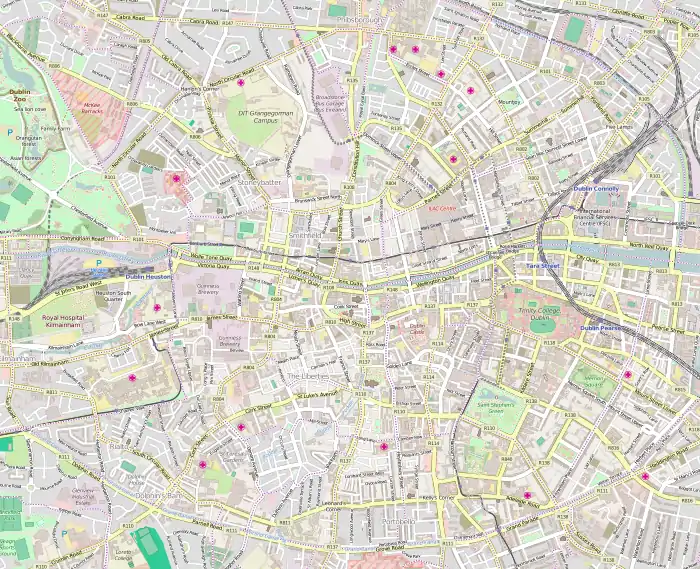Dawson Street
Dawson Street (/ˈdɔːsən/; Irish: Sráid Dásain) is a street on the southern side of central Dublin, running from St Stephen's Green to the walls of Trinity College Dublin. It is the site of the residence of the Lord Mayor of Dublin, the Mansion House.
 | |
 | |
| Native name | Sráid Dásain (Irish) |
|---|---|
| Namesake | Joshua Dawson |
| Length | 400 m (1,300 ft) |
| Width | 14 metres (46 ft) |
| Location | Dublin, Ireland |
| Postal code | D02 |
| Coordinates | 53°20′28″N 6°15′30″W |
| north end | Nassau Street |
| south end | St Stephen's Green North |
| Other | |
| Known for | Mansion House, cafés, nightclubs, St. Ann's Church |
History
The street was named after Joshua Dawson who laid out Dawson Street as well as the nearby Grafton, Anne, and Harry Streets,[1] and who built the Mansion House in 1710.[2]
Location
Dawson Street runs parallel to Grafton Street, to which it is connected by Duke Street and South Anne Street. Much of the street is a shopping thoroughfare. Molesworth Street links the street to Kildare Street.
The street has a slight slope downwards from its Stephen's Green end to its Trinity end. Traffic flows one way, northwards.
Buildings and businesses
The Mansion House, the official residence of the Lord Mayor of Dublin, lies near the southern end of the street. Saint Ann's Church is found on the eastern side, almost halfway along. Also at the southern end is Academy House, the home of the Royal Irish Academy since 1851. It was built by Lord Northland in the mid eighteenth century. Near the northern end is the famous bookshop Hodges Figgis.[3]
Famous inhabitants
Noted Irish ecclesiastical architect William Hague had his office at 50 Dawson Street,[4] as did Thomas Francis McNamara (also at No. 50 and No. 5).
Redevelopment
From the 1960s onwards many of the Georgian and Victorian buildings on the street were demolished in favour of modern retail and office units. One such development was on the corner of Dawson Street and Nassau Street by the Norwich Union Group. A collection of 15 Georgian and Victorian buildings were demolished, including the original Elverys Sports corner store[5] and the 1870 McCurdy's Law Club.[6] The new 5-storey t-shaped office block with street level retail units was designed by Lardner and Partners.[5] The new building, completed in 1967 was called Nassau House. Permission was granted to demolish this block in 2016,[7] and the construction of a replacement mixed-use development is due for completion in 2022.[8]
The Royal Hibernian Hotel was a prominent landmark on the street, until its demolition in 1984, only 4 years after a extensive renovation.[9] It was purported to be the oldest hotel in Ireland. The hotel was replaced with a large mixed-use development, the Royal Hibernian Way, completed in 1987.[10][11]
Luas
Luas Green Line | |||||||||||||||||||||||||||||||||||||||||||||||||||||||||||||||||||||||||||||||||||||||||||||||||||||||||||||||||||||||||||||||||||||||||||||||||||||||||||||||||||||||||||||||||||||||||||||||||||||||||||||||||||||||||||||||||||||||||||||||||||||||||||||||||||||||||||||||||||||||||||||||||||||||||||||||||||||||||||||||||||||||||||||||||||||||||||||||||||||||||||||||||||
|---|---|---|---|---|---|---|---|---|---|---|---|---|---|---|---|---|---|---|---|---|---|---|---|---|---|---|---|---|---|---|---|---|---|---|---|---|---|---|---|---|---|---|---|---|---|---|---|---|---|---|---|---|---|---|---|---|---|---|---|---|---|---|---|---|---|---|---|---|---|---|---|---|---|---|---|---|---|---|---|---|---|---|---|---|---|---|---|---|---|---|---|---|---|---|---|---|---|---|---|---|---|---|---|---|---|---|---|---|---|---|---|---|---|---|---|---|---|---|---|---|---|---|---|---|---|---|---|---|---|---|---|---|---|---|---|---|---|---|---|---|---|---|---|---|---|---|---|---|---|---|---|---|---|---|---|---|---|---|---|---|---|---|---|---|---|---|---|---|---|---|---|---|---|---|---|---|---|---|---|---|---|---|---|---|---|---|---|---|---|---|---|---|---|---|---|---|---|---|---|---|---|---|---|---|---|---|---|---|---|---|---|---|---|---|---|---|---|---|---|---|---|---|---|---|---|---|---|---|---|---|---|---|---|---|---|---|---|---|---|---|---|---|---|---|---|---|---|---|---|---|---|---|---|---|---|---|---|---|---|---|---|---|---|---|---|---|---|---|---|---|---|---|---|---|---|---|---|---|---|---|---|---|---|---|---|---|---|---|---|---|---|---|---|---|---|---|---|---|---|---|---|---|---|---|---|---|---|---|---|---|---|---|---|---|---|---|---|---|---|---|---|---|---|---|---|---|---|---|---|---|---|---|---|---|---|---|---|---|---|---|---|---|---|---|---|---|---|---|---|---|---|---|---|---|---|---|---|---|---|---|---|---|---|---|---|---|---|---|---|---|---|
| |||||||||||||||||||||||||||||||||||||||||||||||||||||||||||||||||||||||||||||||||||||||||||||||||||||||||||||||||||||||||||||||||||||||||||||||||||||||||||||||||||||||||||||||||||||||||||||||||||||||||||||||||||||||||||||||||||||||||||||||||||||||||||||||||||||||||||||||||||||||||||||||||||||||||||||||||||||||||||||||||||||||||||||||||||||||||||||||||||||||||||||||||||
Dawson Luas stop is on the Luas Cross City extension. The line links the Red and Green lines going from Broombridge in North Dublin (interchange with Irish Rail station) and St. Stephen's Green Green Line stop. Construction started in June 2013 with services beginning on 9 December 2017.[12][13]
References
- Irish Place and Street Names
- "Dictionary of Ulster Biography". Archived from the original on 6 February 2012. Retrieved 8 October 2006.
- "History of the Academy". www.ria.ie. Retrieved 4 December 2020.
- Gerry Convery. Poetry in Stone: Sacred Heart Church. (Omagh: Drumragh RC Parish, 1999), p.57
- McDonald 1985, p. 15.
- "1967 - Norwich Union, Nassau Street, Dublin". Archiseek - Irish Architecture. 16 February 2010. Retrieved 3 November 2020.
- Daly, Gavin (2 October 2016). "Nassau House to fall". The Sunday Times. Retrieved 3 November 2020.
- Quinlan, Ronald (30 October 2019). "BCP and Meyer Bergman secure €100m towards Dublin 2 scheme". The Irish Times. Retrieved 3 November 2020.
- McDonald 1985, p. 103.
- Oram, Hugh (11 May 2006). "An Irishman's Diary". The Irish Times. Retrieved 9 January 2021.
- "The History of Dawson Street". DublinTown. 20 March 2020. Retrieved 9 January 2021.
- "Green light given to Luas link-up, first passengers 2017". RTÉ. Archived from the original on 5 August 2012. Retrieved 5 August 2012.
- "Taoiseach launches new Luas Cross City service in Dublin". RTÉ. 9 December 2017. Retrieved 9 December 2017.
Sources
- McDonald, Frank (1985). The Destruction of Dublin. Gill and MacMillan. ISBN 0-7171-1386-8.CS1 maint: ref=harv (link)